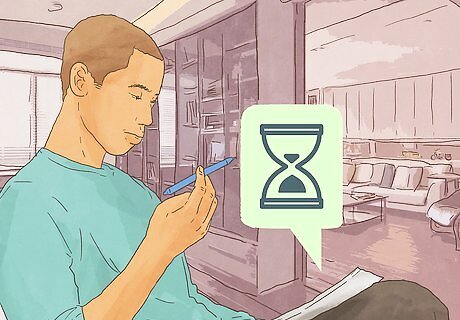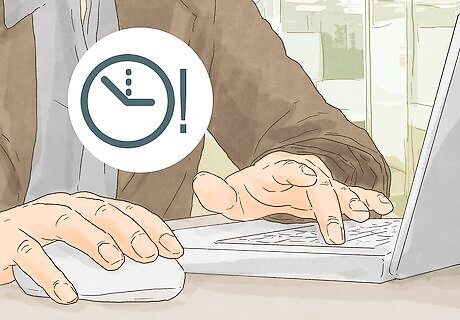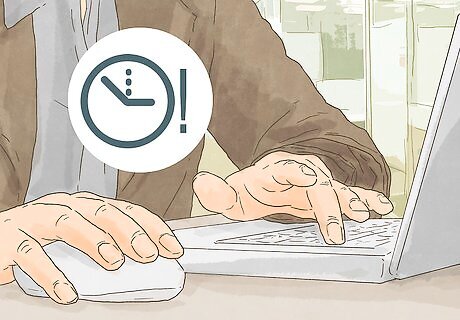
views
Choosing a Data Recording Method

Use work sampling if you have limited time to record. In this approach, you observe the person at certain times rather than continuously. The intervals can be regular or random. You observe the person for a given time, and then extrapolate from the samples how much time is spent on each task. This type works better on tasks that have fewer components or workers that do fewer tasks overall. For instance, if a person's main job is invoicing, random sampling can work because each time you check in, you get a snapshot of what the person is doing. Once you have all the data, you can figure out which task or component the person spends the most time on by looking at how often and how long it showed up in each random sample. The benefit with this method is you can observe more than one person in a set time period by rotating through each person. If you're using this method on yourself, set up an alarm to go off at certain intervals so you can record what you're doing for a set amount of time.

Observe the task in real time to be able to ask questions. In this approach, you are in the room with the person as they do the task. Observe what they do, breaking the task into smaller components as you record times. Each component should make sense as a whole without getting so detailed that you can't keep up. Timing a large task isn't helpful without looking at the components of each task. If you analyze the components, you can look for inefficiencies. You won't stop the person; you're just breaking down the task for recording purposes. For instance, if the task is checking the mail, the components would include walking to the mail area, finding the mail, taking it back to the desk, opening envelopes, reading the mail, and discarding or dealing with each letter. It can help to have a group for observation. That way, you can have one person to work the stopwatch, 1 person to record times, and 1 person to make notes. You can also use this approach on yourself. In that case, you'll be writing down each component as you do it.

Record a video to make the participant perform more naturally. Instead of observing the tasks in real time, take a video. That way, you can go back later and analyze how long each task takes. You won't miss as much because you can always rewind the video to see something again.

Record a video of yourself to perform a more accurate study. If you're doing the study on yourself, this approach will be much easier than the other 2. Set up a camera on a tripod in a place that can capture what you're doing. Let it record while you go through a set task, such as writing a report. Test the task over a given period. For example, you may want to test it over a week or even a month.
Performing the Study

Set up a spreadsheet to record data on. You'll need a place to write what the task is, and a spreadsheet is ideal. Next to it, you'll need a place for the time. Often, tasks are done in batches. If that's the case, have a place to record the time for each component of each task. You'll just need a set of numbered boxes for this part. Also add a column for notes. For instance, if the task is checking email and one of the components is reading email, make a record of the time it takes to read each email in the numbered boxes next to the component.

Divide work into small categories. Part of performing a time and motion study is figuring out exactly how much time is spent on each task. Generally, the only way to improve efficiency is to look at the small actions within each task. As the work is being done, establish each component of the task and write a short description down. The key is finding the right level of detail. You don't want to be overly detailed, as timing how long it takes to hit a single button isn't useful. However, you also don't want to be too broad, as that won't give you enough data to work on efficiency. Say you're checking email. You might break it down into logging on to the computer and into your email, deleting spam mail without opening, reading emails, composing replies, and organizing email into folders.

Time each task. Start with a stopwatch. Time each component of the task, jotting down the time it took to complete each component. It's often easier to just stop and start the timer, using the elapsed time. You can go in later and figure out how many seconds were spent on each task. For more accuracy, take data over multiple days.

Time tasks using video. When you're using a video, you'll need to stop and start the video for each component you're timing. That way, you'll have time to write down your notes and the times for each component.
Analyzing the Results and Making Changes

Average out the times for each component. After you're done, take the times for each component and find the average. To find an average, add all the times for 1 component together, and then divide by the number of times in that group. For instance, if you have reading emails as the component, the times might be 65 seconds, 210 seconds, 240 seconds, 39 seconds, and 354 seconds. Add the numbers together: 65 + 210 + 240 + 39 + 354 to equal 908. Divide by the number of times. In this case, that's 5, so divide 908 by 5 to get 181.6 seconds on average per email.

Find the average time for the task. The easiest way to find the average time for the whole task is to simply add all the averages for the components together. That will give you the average for the whole task.

Assign a high or low value to your tasks. Assigning a high or low value to each task can help your prioritize what's important. You don't have to assign a number; just label them as high value or low value. For instance, answering emails at your job may be important, but unless you're in customer service, it likely has a lower value overall than finishing an important report.

Cut back on low-value, high-time tasks. After you've rated your tasks, look at which tasks take a large amount of time while having a low value overall. Those are the tasks that you need to figure out how to cut back. It's also important to look at the tasks that take a lot of time but also have high value. It doesn't hurt to try to make these tasks more efficient.

Watch for multitasking. Multitasking tends to make each individual task take longer because you can't give either your full attention. In cases where you're multitasking, such as going back and forth between email and writing a report, try changing up. Set a time period where you are only doing one thing. If you're writing a report, ignore your email. If you read email constantly throughout the day, you're constantly pulling your train of thought from whatever else you're doing. Often, it's better to do all of a task at once, such as only reading emails in the morning, at midday, and right before you leave work.

Look for inefficiencies to cut back on them. Often, you'll find inefficiencies in the routines you time and describe. Eliminating inefficiencies can help you work better and get more done in the time you have. For instance, if you must file paperwork daily in another room away from your office, consider saving it to do all at once. If you are constantly going back and forth, that takes away time you could be spending on other tasks.




















Comments
0 comment